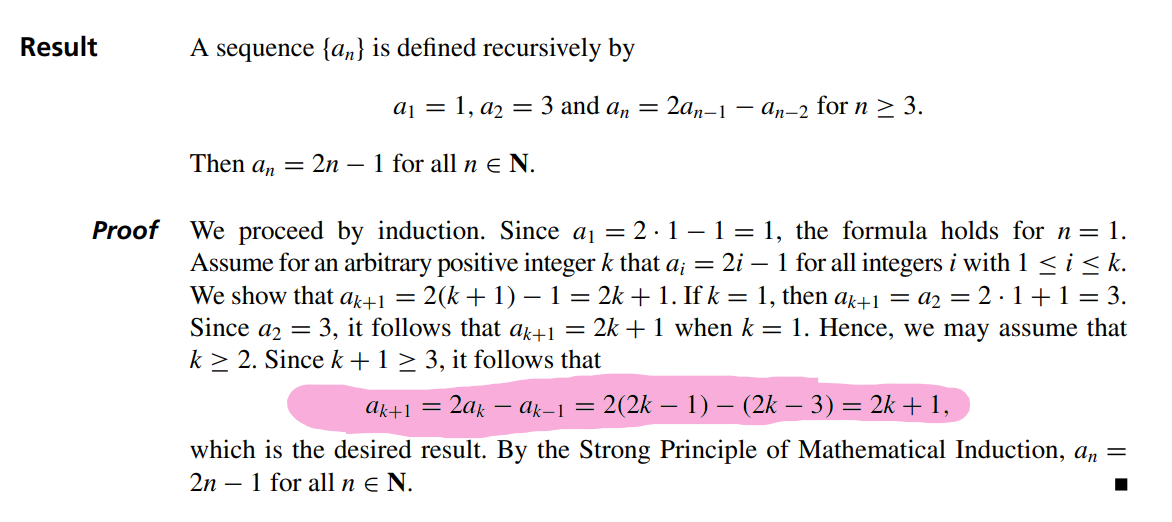Result Proof A sequence {an} is defined recursively by a₁ = 1, a₂ = 3 and an = 2an-1 Then an = 2n - 1 for all ne N. -an-2 for n ≥ 3. We proceed by induction. Since a₁ = 2 · 1 − 1 = 1, the formula holds for n = 1. Assume for an arbitrary positive integer k that a; = 2i - 1 for all integers i with 1 ≤ i ≤k. We show that ak+1 = 2(k+ 1) − 1 = 2k + 1. If k = 1, then ak+1 = a₂ = 2·1+1 = 3. Since a2 = 3, it follows that ak+1 = 2k + 1 when k = 1. Hence, we may assume that k≥ 2. Since k + 1 ≥ 3, it follows that ak+1 = 2ak - ak-1 = 2(2k – 1) – (2k − 3) = 2k + 1, which is the desired result. By the Strong Principle of Mathematical Induction, an 2n 1 for all n € N. =
Result Proof A sequence {an} is defined recursively by a₁ = 1, a₂ = 3 and an = 2an-1 Then an = 2n - 1 for all ne N. -an-2 for n ≥ 3. We proceed by induction. Since a₁ = 2 · 1 − 1 = 1, the formula holds for n = 1. Assume for an arbitrary positive integer k that a; = 2i - 1 for all integers i with 1 ≤ i ≤k. We show that ak+1 = 2(k+ 1) − 1 = 2k + 1. If k = 1, then ak+1 = a₂ = 2·1+1 = 3. Since a2 = 3, it follows that ak+1 = 2k + 1 when k = 1. Hence, we may assume that k≥ 2. Since k + 1 ≥ 3, it follows that ak+1 = 2ak - ak-1 = 2(2k – 1) – (2k − 3) = 2k + 1, which is the desired result. By the Strong Principle of Mathematical Induction, an 2n 1 for all n € N. =
College Algebra
7th Edition
ISBN:9781305115545
Author:James Stewart, Lothar Redlin, Saleem Watson
Publisher:James Stewart, Lothar Redlin, Saleem Watson
Chapter8: Sequences And Series
Section8.5: Mathematical Induction
Problem 33E
Related questions
Question
Please show how the highlighted part works step by step, I dont get the substitution, how do we get ak=2k-1 and
ak-1=2k-3?

Transcribed Image Text:Result
Proof
A sequence {an} is defined recursively by
a₁ = 1, a₂ = 3 and an = 2an-1
Then an = 2n - 1 for all ne N.
-an-2 for n ≥ 3.
We proceed by induction. Since a₁ = 2∙1 − 1 = 1, the formula holds for n = 1.
Assume for an arbitrary positive integer k that a; = 2i - 1 for all integers i with 1 ≤ i ≤k.
We show that ak+1 = 2(k+ 1) − 1 = 2k + 1. If k = 1, then ak+1 = a₂ = 2·1+1 = 3.
Since a2 = 3, it follows that ak+1 = 2k + 1 when k = 1. Hence, we may assume that
k≥ 2. Since k + 1 ≥ 3, it follows that
ak+1 = 2ak-ak-1 = 2(2k − 1) – (2k − 3) = 2k + 1,
=
which is the desired result. By the Strong Principle of Mathematical Induction, an
2n 1 for all n € N.
Expert Solution
This question has been solved!
Explore an expertly crafted, step-by-step solution for a thorough understanding of key concepts.
Step by step
Solved in 3 steps with 3 images

Follow-up Questions
Read through expert solutions to related follow-up questions below.
Follow-up Question
How do you decide that k is greater than or equal to 2, and k+1 is greater than or equal to 3?
Solution
Recommended textbooks for you

College Algebra
Algebra
ISBN:
9781305115545
Author:
James Stewart, Lothar Redlin, Saleem Watson
Publisher:
Cengage Learning

Algebra & Trigonometry with Analytic Geometry
Algebra
ISBN:
9781133382119
Author:
Swokowski
Publisher:
Cengage

College Algebra (MindTap Course List)
Algebra
ISBN:
9781305652231
Author:
R. David Gustafson, Jeff Hughes
Publisher:
Cengage Learning

College Algebra
Algebra
ISBN:
9781305115545
Author:
James Stewart, Lothar Redlin, Saleem Watson
Publisher:
Cengage Learning

Algebra & Trigonometry with Analytic Geometry
Algebra
ISBN:
9781133382119
Author:
Swokowski
Publisher:
Cengage

College Algebra (MindTap Course List)
Algebra
ISBN:
9781305652231
Author:
R. David Gustafson, Jeff Hughes
Publisher:
Cengage Learning

Algebra and Trigonometry (MindTap Course List)
Algebra
ISBN:
9781305071742
Author:
James Stewart, Lothar Redlin, Saleem Watson
Publisher:
Cengage Learning